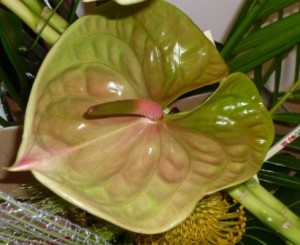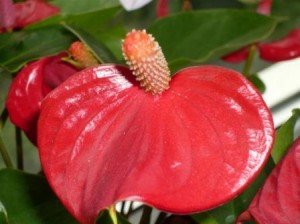Aroid or Alcea Family

You may be wondering what is an Aroid? According to my Gardeners Encyclopedia it is any plant belonging to the family Aracea such as Arum Lilies, Anthuriums, Philodendron or Monstera. They are characterised by the cylindrical Spadix densely packed with tiny flowers, with the male on top of the female and having a single Bract known as a Spathe.
Aroids are grown primarily for the Spathe which is the most showy part of the plant. It may be flat as with the Anthurium below or rolled around the Spathe as with Calla Lilies or Lords and Ladies.

Alcea is the family name for Hollyhocks. Alcea Rosea is the common garden Hollyhock and they come in a range of colours with either single or double flowers (see top and bottom picture). Dutch Hollyhock Alcea Ficifolia is a yellow flowering, hardy plant that can grow 6 to 9 foot tall. Alcea have petals rather than a Spathe.
The Spathe is the red waxy part of the Anthurium and the spike is called the Spadix which contains male and female flowers. Both the Spathe and the Spadix can be a variety of colours from white, pink, green, or now even orange.
There are many species of Anthurium and some are very popular with the florist trade as pot plants or cut flowers for interior decoration. Most hybrids are based on A. andreanum or A. scherzerianum because of their colorful spathes. Anthurium can also be called “Flamingo Flower” or “Boy Flower”. They also include forms such as Anthurium crystallinum peltifolium with large, velvety, darkgreen leaves and silvery white venation.
There are profusions of these flowers in Madeira where they suit the mild climate. In the UK they need a sheltered, warm situation and indoor environment in winter. As house plants they tolerate lower light levels than many flowering plants but need temperatures above 60 degrees. Propagate by cutting with at least 2 leaf joints into a sandy peat mixture

One thought on “Aroid or Alcea Family”
Comments are closed.